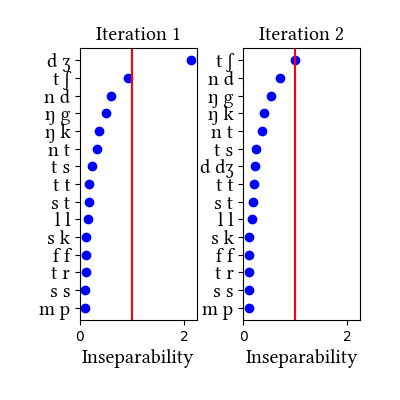Standard Italian (Indo-European)
Italian is a descendant of Latin, which we discuss in its own section in the paper. Italian inherited four affricates from Latin, which were created through palatalization of coronal and dorsal stops. The arguments for a synchronic analysis of these sounds as affricates are somewhat delicate, primarily resting on morpho-phonological alternation patterns (e.g., stoma[k]o ~ stoma[tʃ]i "stomach sg. ~ stomach pl."). Affricates are phonotactically restricted in Italian: they do not occur in word-initial consonant clusters, unlike other stops (thus, *#tʃl, *#dzr). Krämer (2009), The Phonology of Italian, also points out that the affricates are defective in word-initial position in other ways: the voiced one is comparatively rare. We tried only one source of data for Italian, Schott's (modified) transcriptions of the OpenOffice spellchecker dictionary wordlist. It's not the best data source. We tried two simulations: one included geminates in the initial state consonant inventory, and the other transcribed them as clusters of two identical segments. This has pretty dramatic effects on the outcome, which never looks quite right for the language.
Simulation data at a glance
Click on simulation name to view additional simulation details.
| Simulation name | Initial state Learning Data | Initial state features |
|---|---|---|
| Nogem | LearningData.txt | Features.txt |
| Gem | LearningData.txt | Features.txt |
Simulation details for Italian nogem
| Iteration | Learning Data produced | Features produced | Inseparability | New Segments added | Segments removed |
|---|---|---|---|---|---|
| 1 | LearningData.txt | Features.txt | [download] [view] | dʒ | ʒ |
| 2 | No new learning data | No new features | [download] [view] | None | None |

